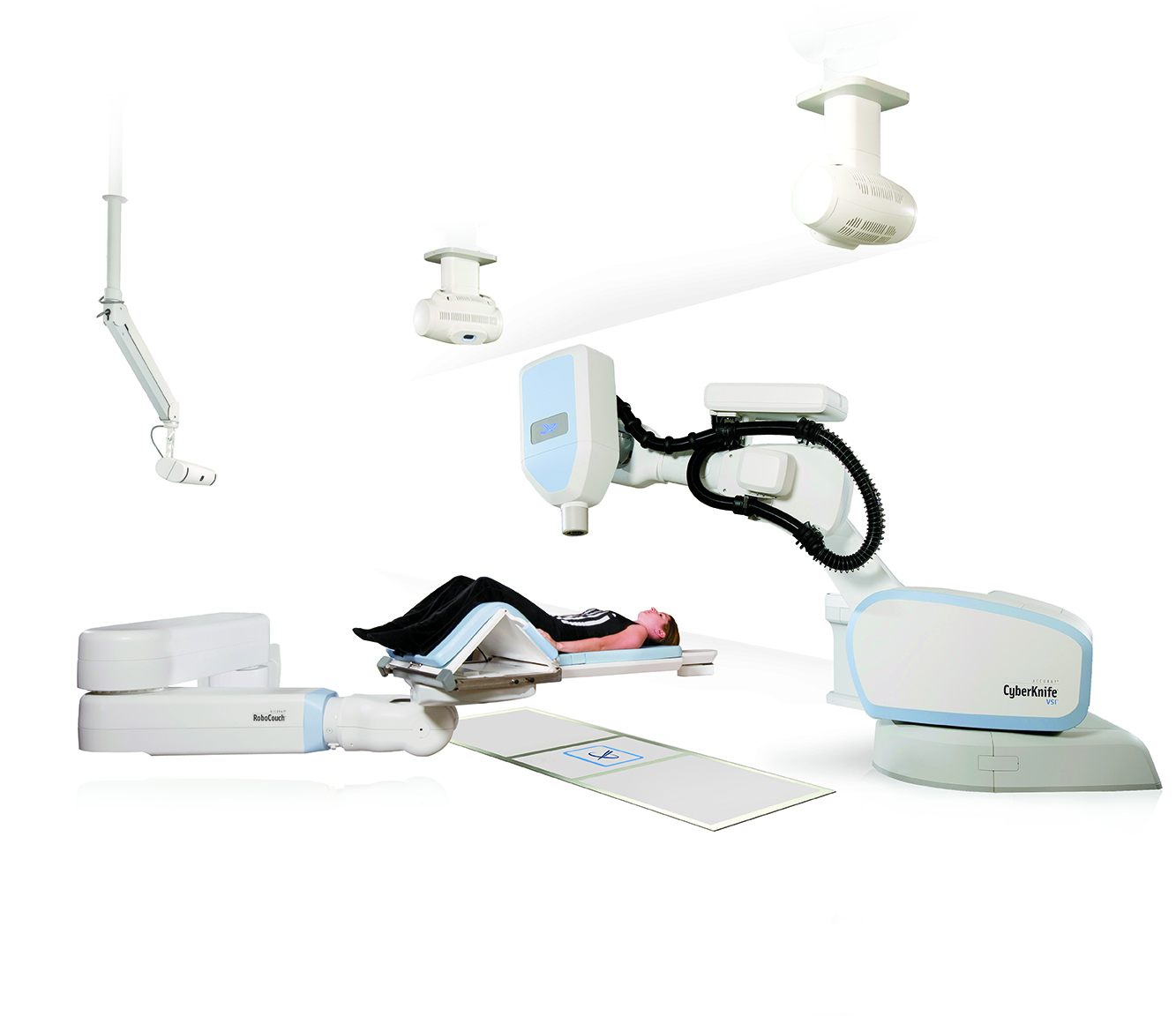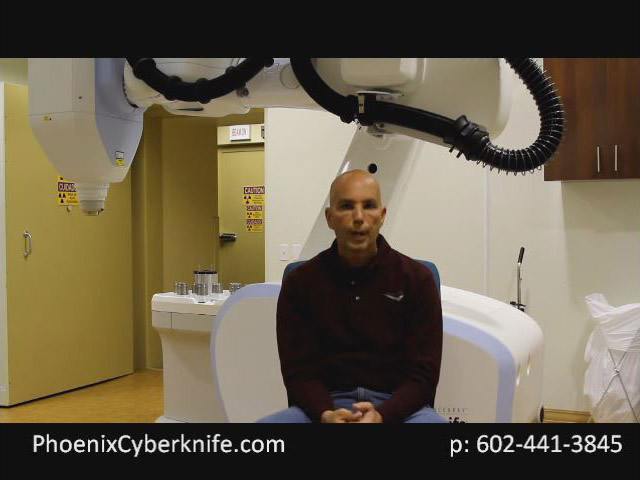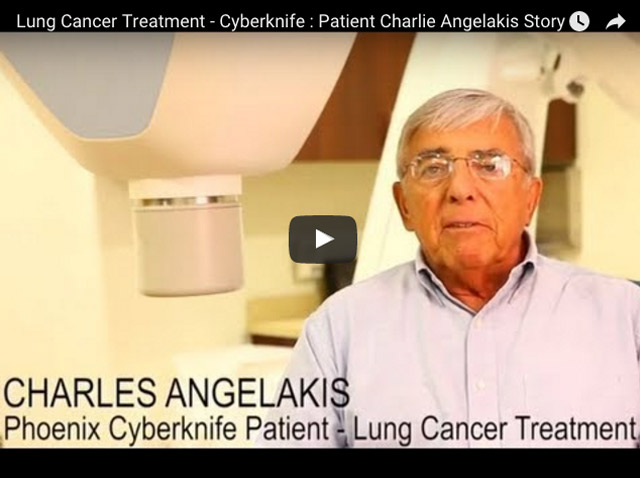Lung Cancer
CyberKnife Lung Cancer Treatment Explained
Clinical Summary
Our very own Dr. John Kresl co-authored a clinical trial that compared the results of treating operable, stage I, non-small-cell lung (NSCLC) cancer patients using one of two treatments: lobectomy (surgery) or stereotactic ablative radiotherapy (SABR). The findings of this randomized study indicated that SABR could be an option for treating operable stage I NSCLC with 95% survival rate after 3 years compared to 79% survival rate with the surgery group.
Early Stage Lung Cancer Treatment Comparison: Survival Rate
| CyberKnife SABR | Surgery |
|---|---|
| 95% | 75% |
CyberKnife Offers Alternative to Surgery for Stage I/II Non-Small Cell Lung Cancer
In 2015, an estimated 221,200 new cases of lung cancer were diagnosed and the disease was expected to cause 158,040 deaths in the United States, according to the American Cancer Society.
For patients with Stage I/II non-small cell lung cancer (NSCLC), surgery is the most common treatment. While external radiation therapy (XRT) was an option, its use has been limited because treatment planning systems were primitive, there was limited shielding capability and a lack of energy modulation. Modern day radiation treatment systems, however, have addressed these limitations and are showing promise as an effective and non-invasive alternative to surgery. Patients with Stage I/II NSCLC are now offered options such as stereotactic body radiation therapy (SBRT, also known as stereotactic ablative radiotherapy (SABR)), intensity-modulated radiation therapy (IMRT), and 3-dimensional conformal radiation therapy (3-D CRT). These technologies enable doctors to deliver high doses of radiation to the lung tumors with extreme precision, while minimizing the damage to healthy surrounding lung tissue and organs.
Use of SBRT/SABR, IMRT and 3-D CRT has been studied since 2002, and results have shown that this type of precise radiation delivery compares favorably to surgery. Dr. John Kresl, medical director at Phoenix CyberKnife Center, co-authored a recently published study, which highlights the first randomized trial comparing SBRT/SABR to surgery. In this study, SBRT/SABR proved superior to surgery with regard to survival, and complications also were markedly less. In the SBRT/SABR group, 10 percent patients had grade 3 complications, which included chest wall pain, cough, shortness of breath, fatigue, and one case of rib fracture. There were no deaths in the group treated by SBRT/SABR. In the group who underwent surgery, 48 percent of patients experienced grade 3 complications and 4 percent of patients died.
The CyberKnife System is recognized as the most effective SBRT/SABR treatment technology in use today. In contrast to surgery, CyberKnife delivers robotic treatments that are painless, non-invasive and done on an outpatient basis in five days. Using advanced motion tracking technology, the CyberKnife System tracks tumors while patient’s breath normally, enabling extremely precise delivery of radiation and limiting damage to surrounding healthy tissue. Each CyberKnife treatment takes about 30 minutes to deliver. Patients typically require little to no recovery time, and can resume normal activities almost immediately after treatment.
Find the Clinical Data from this study here.
The CyberKnife System
Using SABR, sometimes known as stereotactic body radiotherapy (SBRT), the CyberKnife System is an advanced, non-invasive alternative to surgery. CyberKnife delivers high doses of radiation directly to the tumor with exact precision and sub-millimeter accuracy. Using robotic technology, CyberKnife is the only system that is able to track the movement of the tumor in real time. Treatment with CyberKnife is performed on an outpatient basis, typically within one to five consecutive days.
CyberKnife can be used in conjunction with other treatments, such as surgery and chemotherapy, but it can also serve as the standalone treatment for both operable and inoperable lung cancer. There are no surgical side effects with CyberKnife and no pain during treatment. It is a viable alternative to surgery that is completely non-invasive, particularly for patients whose health may not tolerate an invasive procedure.

Novalis TrueBeam STx with ExacTrac
TrueBeam STx optimizes both radiotherapy and radiosurgery. TrueBeam utilizes real-time imaging, beam delivery, and motion management to deliver higher doses of radiation targeted at smaller areas, including the lung. Like CyberKnife, TrueBeam provides a comfortable experience for patients undergoing treatment.
Treatment Process
The treatment process with CyberKnife has proven to be extremely effective in treating lung cancer, particularly in its early stages. Tumors found in the lung are constantly moving due to respiration. Conventional radiotherapy treatments are less effective in ensuring that the tumor receives constant radiation during treatment due to its respiratory movements. CyberKnife is the only radiotherapy system that is able to track the tumor in real time, delivering high doses of radiation directly at the tumor. With sub-millimeter accuracy, this precision minimizes exposure to surrounding organs, tissues, and nerves. The patient can relax and breathe normally while CyberKnife’s robotic arm does the rest.
Proper treatment for lung cancer depends on the type of cancer and its stage. The most common treatments for lung cancer includes surgery, chemotherapy, and radiation therapy. In recent years, radiation therapy treatments have shown increased success rates in treating operable and inoperable lung tumors.
Lung Cancer Types & Stages
There are two types of lung cancer: Non-small cell lung cancer and small cell lung cancer. Non-small lung cancer is the most common type of lung cancer, particularly squamous cell carcinoma and adenocarcinoma.
Non-Small Cell Lung Cancer Stages
- Stage I -The cancer is only located in the lungs without spreading to any lymph nodes.
- Stage II -The cancer is found in both the lungs and nearby lymph nodes.
- Stage III -The cancer has spread from the lungs to other lymph nodes in the chest. If the cancer has spread to lymph nodes on one side of the chest, it is known as Stage IIIA. If the cancer has spread to lymph nodes on both sides as well as the collarbone, then it is known as Stage IIIB.
- Stage IV -The most advanced stage where the cancer has spread to both lungs, the fluid around the lungs, or to other parts and organs in the body.
Small Cell Lung Cancer Stages
- Limited Stage -The cancer is found on one side of the chest, affecting the lung and surrounding lymph nodes.
- Extensive Stage -The cancer is found in other areas of the chest or other parts of the body.
Inoperable Lung Tumors
There are various factors that may make lung tumors inoperable: cancer stage, patient age, patient health, etc. Both CyberKnife and TrueBeam STx can be used to treat inoperable tumors in the lung. These advanced radiotherapy technologies are completely non-invasive; the patient simply relaxes while radiation is delivered in high doses with exact precision and accuracy, minimizing exposure to surrounding tissues and organs.
Recurrent Lung Tumors
Cancers that have gone into remission after treatment may still come back. If cancer returns after treatment, it is known as a recurrent cancer. Treatment options for recurrent lung tumors may vary depending and a number of factors. Based on your unique condition, you may receive additional radiation therapy to treat a recurrent lung tumor.
Metastatic Lung Tumors
Metastasis, or Metastatic Tumors, is when the cancer has spread from the place of origin to other parts of the body. If lung cancer spreads to other organs or areas in the body, the cancer cells remain the same as those found in the original tumor. Metastatic lung tumors can be treated with CyberKnife or other radiotherapy technologies, such as TrueBeam STx, depending on the unique condition of the patient. Our team of board-certified cancer doctors will evaluate your condition to determine which treatment option will be right for your metastatic tumor.
Treatment options for lung cancer will vary depending on the type of lung cancer you have and its stage. Your overall health, age, and other factors will also influence which treatment is right for your unique condition. Lung cancer is often treated with surgery, chemotherapy, and radiation therapy, or a combination of these for the most effective treatment.
Surgery
Surgery or surgical resection is often used to remove a tumor. For early stage lung cancer, the preferred treatment for otherwise healthy patients is a lobectomy, in which the surgeon removes a lobe of the lung. Lobectomies can be performed in two ways.
One method is called a thoracotomy, in which the ribs are cut and spread to allow the surgeon to access the lobe of lung that needs to be removed. The second type of lobectomy is less invasive and done using video-assisted thoracoscopic surgery (VATS). During this procedure, small incisions are made and a camera is placed in the chest to guide the surgeon performing the surgery. Some patients with early stage lung cancer may not require that an entire lobe be removed. This procedure is called a wedge resection or segmentectomy, and can reduce the amount of normal lung tissue removed.
To be effective as possible, lung cancer surgery must not only remove the visible tumor, but eliminate any microscopic traces of the disease that remain in the surrounding tissue. Studies comparing lobectomies to wedge resections have shown that the lobectomy results in better survival rates and is more effective in removing all of a patient’s disease.
For those patients whose primary lung cancer is more advanced, as well as those who have large tumors that cannot be removed by lobectomy or segmentectomy, more extensive surgery is required. In these cases, surgeons may perform a pneumonectomy, during which the entire lung is removed.
Although surgery is effective for some stages of lung cancer, patients can experience significant risk of complications, including infection, bleeding, and respiratory and cardiac problems. These complications can also lead to loss of lung function and/or a decreased quality of life.3 Open lobectomy and video-assisted thoracoscopic surgery have local control rates and 5-year survival rates of 60-80%.4-7
Lung cancer surgery is typically used alone for patients with very small tumors and early-stage lung cancer. However, some patients may not be well enough to undergo surgery because they suffer from other cardiac or breathing problems. For later stages of lung cancer, surgery is often combined with chemotherapy and, perhaps, radiation therapy.
Chemotherapy
Chemotherapy is used when cancer cells are thought to be located throughout the body or they are present in a patient’s blood or other fluids, which is often the case with metastatic lung tumors and advanced-stage lung cancer. Chemotherapy medication is delivered orally or through an IV (into a vein), and is given to a patient either as the sole treatment or in combination with surgery or radiation. Chemotherapy affects both normal tissue and the cancer cells, so patients may experience side effects, such as severe nausea and vomiting, infections, fatigue and weight loss.22 Based on randomized clinical trials chemotherapy is recommended in addition to local treatment for patients with later-stage disease. Disease-free 5-year survival for patients treated with chemotherapy following surgery range from depending on how advanced the disease is.
Understanding Radiation Therapy
Radiation therapy, sometimes called radiotherapy, is the use of radiation to safely treat cancer. Cancer doctors who specialize in radiation therapy are called radiation oncologists. Radiation oncologists use radiation to treat cancer or to keep the cancer from spreading to other areas of the body. Radiation has proven effective in damaging cancer cells, which can keep them from multiplying. Once the cancer cells die, the body eliminates them. Radiation does affect healthy cells; however, there are new technologies, such as the CyberKnife System, that minimize radiation exposure to healthy cells. Also, healthy cells are able to repair themselves in ways that cancer cells cannot.
External Beam Radiation Therapy
Radiation therapy treatments use a beam of radiation outside the body to treat cancer cells and tumors inside the body. Conventional radiation therapy uses multiple radiation fields on the tumor while also protecting healthy tissue. There are many forms of external beam radiation therapy:
- 3-dimensional conformal radiotherapy (3D-CRT) delivers precise doses of radiation to the lung tumor using multiple radiation treatment fields. Each radiation beam is targeted directly on the tumor in order to protect surrounding healthy tissues.
- One form of 3D-CRT includes intensity modulated radiation therapy (IMRT), which will adjust the intensity of each beam of radiation.
- Another form of 3D-CRT is called stereotactic body radiation therapy (SBRT), and stereotactic ablative radiotherapy (SABR), which delivers higher doses of radiation in a shorter period of time, typically between one to five days. SBRT and SABR are only available at select cancer centers throughout the country, and Phoenix CyberKnife has the two most advanced technologies – CyberKnife and the Novalis TrueBeam STx for delivering this.
Internal Radiation Therapy
Internal radiation involves treating the tumor with radioactive materials that are placed inside the body into or near the tumor. This treatment, known as brachytherapy, utilizes thin plastic tubes which are connected to a brachytherapy machine. The machine then delivers tiny radioactive materials through the tubes near the tumor. Once treatment has been completed, the tubes are removed, leaving the radioactive materials to treat the tumor. In cases involving lung cancer, the tubes are placed into your nose to access the airways of the lung.
What is Lung Cancer?
Lung cancer is the presence of a tumor in the lung as a result of an abnormal growth of cells. If these cells originated in the tumor, then it is known as primary lung cancer. If these cancerous cells originated in another organ and reached the lung through the bloodstream, then it is metastatic lung cancer.
The American Cancer Society projected 221,200 new cases of lung cancer and 158,040 deaths from the disease in the United States in 2015. Most deaths occur in patients with Stage III or Stage IV lung cancer.
Types
There are two types of lung cancer. The most common type is non-small cell lung cancer, such as squamous cell carcinoma and adenocarcinoma. The second and less common type is small cell lung cancer, which in the past was frequently referred to as oat cell cancer.
Risks
Smoking is the leading cause of lung cancer, resulting in 85% to 90% of all lung cancer cases. Other risk factors that contribute to the development of lung cancer include:
- Second-hand smoke
- Air pollution
- Asbestos
- Radon
- Tubercolosis
Signs and Symptoms
Though not everyone with lung cancer will exhibit symptoms, particularly in its early stages, there are some common symptoms to be aware of:
- Persistent cough
- Shortness of breath
- Coughing blood
- Chest pain
- Pneumonia or bronchitis
- Weight loss, lack of appetite, or fatigue
- Swelling of the neck and face
Detection
Typically, primary lung cancer does not cause any symptoms in its early stages. In many cases, the cancer has advanced when symptoms begin to occur. Many patients end up going to the doctor for a persistent cough, coughing up blood, shortness of breath, etc., and it usually these symptoms that can influence doctors to order a chest X-Ray, CT scans (Computed Tomography), PET-CT scans (Positron Emission Tomography-Computed Tomography), and MRIs (Magnetic Resonance Imaging). These scans and chest X-Rays can indicate the presence of cancer in the lung or in other parts of the body.
Diagnosis
Diagnosing lung cancer is then done by either performing a biopsy, examining a small piece of tissue, or by analyzing fluid to identify the presence of a protein specific to tumor cells. Doctors will then determine the stage of lung cancer by examining the size of the tumor and whether or not it has spread, and to what extent.
Patient Education
CyberKnife – Lung Tumors
CyberKnife Explained by Lung Surgeons
TrueBeam STx – Lung Tumors
Patient Testimonials
Joseph - Stage IV Lung Cancer Part 1
Joseph - Stage IV Lung Cancer Part 2
Joseph’s CyberKnife Treatment – Stage IV Lung Cancer and Brain Mets
Charlie’s CyberKnife Treatment – Lung Cancer
Joe & Camille's CyberKnife Treatment - Lung Cancer Part 1
Joe & Camille's CyberKnife Treatment - Lung Cancer Part 2
Jean's CyberKnife Treatment - Lung Cancer
Kay's CyberKnife Treatment - Lung Cancer
Judith's CyberKnife Treatment - Lung Cancer
CyberKnife Lung Cancer Treatment Explained
Clinical Summary
Our very own Dr. John Kresl co-authored a clinical trial that compared the results of treating operable, stage I, non-small-cell lung (NSCLC) cancer patients using one of two treatments: lobectomy (surgery) or stereotactic ablative radiotherapy (SABR). The findings of this randomized study indicated that SABR could be an option for treating operable stage I NSCLC with 95% survival rate after 3 years compared to 79% survival rate with the surgery group.
Early Stage Lung Cancer Treatment Comparison: Survival Rate
| CyberKnife SABR | Surgery |
|---|---|
| 95% | 75% |
CyberKnife Offers Alternative to Surgery for Stage I/II Non-Small Cell Lung Cancer
In 2015, an estimated 221,200 new cases of lung cancer were diagnosed and the disease was expected to cause 158,040 deaths in the United States, according to the American Cancer Society.
For patients with Stage I/II non-small cell lung cancer (NSCLC), surgery is the most common treatment. While external radiation therapy (XRT) was an option, its use has been limited because treatment planning systems were primitive, there was limited shielding capability and a lack of energy modulation. Modern day radiation treatment systems, however, have addressed these limitations and are showing promise as an effective and non-invasive alternative to surgery. Patients with Stage I/II NSCLC are now offered options such as stereotactic body radiation therapy (SBRT, also known as stereotactic ablative radiotherapy (SABR)), intensity-modulated radiation therapy (IMRT), and 3-dimensional conformal radiation therapy (3-D CRT). These technologies enable doctors to deliver high doses of radiation to the lung tumors with extreme precision, while minimizing the damage to healthy surrounding lung tissue and organs.
Use of SBRT/SABR, IMRT and 3-D CRT has been studied since 2002, and results have shown that this type of precise radiation delivery compares favorably to surgery. Dr. John Kresl, medical director at Phoenix CyberKnife Center, co-authored a recently published study, which highlights the first randomized trial comparing SBRT/SABR to surgery. In this study, SBRT/SABR proved superior to surgery with regard to survival, and complications also were markedly less. In the SBRT/SABR group, 10 percent patients had grade 3 complications, which included chest wall pain, cough, shortness of breath, fatigue, and one case of rib fracture. There were no deaths in the group treated by SBRT/SABR. In the group who underwent surgery, 48 percent of patients experienced grade 3 complications and 4 percent of patients died.
The CyberKnife System is recognized as the most effective SBRT/SABR treatment technology in use today. In contrast to surgery, CyberKnife delivers robotic treatments that are painless, non-invasive and done on an outpatient basis in five days. Using advanced motion tracking technology, the CyberKnife System tracks tumors while patient’s breath normally, enabling extremely precise delivery of radiation and limiting damage to surrounding healthy tissue. Each CyberKnife treatment takes about 30 minutes to deliver. Patients typically require little to no recovery time, and can resume normal activities almost immediately after treatment.
Find the Clinical Data from this study here.
The CyberKnife System
Using SABR, sometimes known as stereotactic body radiotherapy (SBRT), the CyberKnife System is an advanced, non-invasive alternative to surgery. CyberKnife delivers high doses of radiation directly to the tumor with exact precision and sub-millimeter accuracy. Using robotic technology, CyberKnife is the only system that is able to track the movement of the tumor in real time. Treatment with CyberKnife is performed on an outpatient basis, typically within one to five consecutive days.
CyberKnife can be used in conjunction with other treatments, such as surgery and chemotherapy, but it can also serve as the standalone treatment for both operable and inoperable lung cancer. There are no surgical side effects with CyberKnife and no pain during treatment. It is a viable alternative to surgery that is completely non-invasive, particularly for patients whose health may not tolerate an invasive procedure.

Novalis TrueBeam STx with ExacTrac
TrueBeam STx optimizes both radiotherapy and radiosurgery. TrueBeam utilizes real-time imaging, beam delivery, and motion management to deliver higher doses of radiation targeted at smaller areas, including the lung. Like CyberKnife, TrueBeam provides a comfortable experience for patients undergoing treatment.
Treatment Process
The treatment process with CyberKnife has proven to be extremely effective in treating lung cancer, particularly in its early stages. Tumors found in the lung are constantly moving due to respiration. Conventional radiotherapy treatments are less effective in ensuring that the tumor receives constant radiation during treatment due to its respiratory movements. CyberKnife is the only radiotherapy system that is able to track the tumor in real time, delivering high doses of radiation directly at the tumor. With sub-millimeter accuracy, this precision minimizes exposure to surrounding organs, tissues, and nerves. The patient can relax and breathe normally while CyberKnife’s robotic arm does the rest.
Proper treatment for lung cancer depends on the type of cancer and its stage. The most common treatments for lung cancer includes surgery, chemotherapy, and radiation therapy. In recent years, radiation therapy treatments have shown increased success rates in treating operable and inoperable lung tumors.
Lung Cancer Types & Stages
There are two types of lung cancer: Non-small cell lung cancer and small cell lung cancer. Non-small lung cancer is the most common type of lung cancer, particularly squamous cell carcinoma and adenocarcinoma.
Non-Small Cell Lung Cancer Stages
- Stage I -The cancer is only located in the lungs without spreading to any lymph nodes.
- Stage II -The cancer is found in both the lungs and nearby lymph nodes.
- Stage III -The cancer has spread from the lungs to other lymph nodes in the chest. If the cancer has spread to lymph nodes on one side of the chest, it is known as Stage IIIA. If the cancer has spread to lymph nodes on both sides as well as the collarbone, then it is known as Stage IIIB.
- Stage IV -The most advanced stage where the cancer has spread to both lungs, the fluid around the lungs, or to other parts and organs in the body.
Small Cell Lung Cancer Stages
- Limited Stage -The cancer is found on one side of the chest, affecting the lung and surrounding lymph nodes.
- Extensive Stage -The cancer is found in other areas of the chest or other parts of the body.
Inoperable Lung Tumors
There are various factors that may make lung tumors inoperable: cancer stage, patient age, patient health, etc. Both CyberKnife and TrueBeam STx can be used to treat inoperable tumors in the lung. These advanced radiotherapy technologies are completely non-invasive; the patient simply relaxes while radiation is delivered in high doses with exact precision and accuracy, minimizing exposure to surrounding tissues and organs.
Recurrent Lung Tumors
Cancers that have gone into remission after treatment may still come back. If cancer returns after treatment, it is known as a recurrent cancer. Treatment options for recurrent lung tumors may vary depending and a number of factors. Based on your unique condition, you may receive additional radiation therapy to treat a recurrent lung tumor.
Metastatic Lung Tumors
Metastasis, or Metastatic Tumors, is when the cancer has spread from the place of origin to other parts of the body. If lung cancer spreads to other organs or areas in the body, the cancer cells remain the same as those found in the original tumor. Metastatic lung tumors can be treated with CyberKnife or other radiotherapy technologies, such as TrueBeam STx, depending on the unique condition of the patient. Our team of board-certified cancer doctors will evaluate your condition to determine which treatment option will be right for your metastatic tumor.
Treatment options for lung cancer will vary depending on the type of lung cancer you have and its stage. Your overall health, age, and other factors will also influence which treatment is right for your unique condition. Lung cancer is often treated with surgery, chemotherapy, and radiation therapy, or a combination of these for the most effective treatment.
Surgery
Surgery or surgical resection is often used to remove a tumor. For early stage lung cancer, the preferred treatment for otherwise healthy patients is a lobectomy, in which the surgeon removes a lobe of the lung. Lobectomies can be performed in two ways.
One method is called a thoracotomy, in which the ribs are cut and spread to allow the surgeon to access the lobe of lung that needs to be removed. The second type of lobectomy is less invasive and done using video-assisted thoracoscopic surgery (VATS). During this procedure, small incisions are made and a camera is placed in the chest to guide the surgeon performing the surgery. Some patients with early stage lung cancer may not require that an entire lobe be removed. This procedure is called a wedge resection or segmentectomy, and can reduce the amount of normal lung tissue removed.
To be effective as possible, lung cancer surgery must not only remove the visible tumor, but eliminate any microscopic traces of the disease that remain in the surrounding tissue. Studies comparing lobectomies to wedge resections have shown that the lobectomy results in better survival rates and is more effective in removing all of a patient’s disease.
For those patients whose primary lung cancer is more advanced, as well as those who have large tumors that cannot be removed by lobectomy or segmentectomy, more extensive surgery is required. In these cases, surgeons may perform a pneumonectomy, during which the entire lung is removed.
Although surgery is effective for some stages of lung cancer, patients can experience significant risk of complications, including infection, bleeding, and respiratory and cardiac problems. These complications can also lead to loss of lung function and/or a decreased quality of life.3 Open lobectomy and video-assisted thoracoscopic surgery have local control rates and 5-year survival rates of 60-80%.4-7
Lung cancer surgery is typically used alone for patients with very small tumors and early-stage lung cancer. However, some patients may not be well enough to undergo surgery because they suffer from other cardiac or breathing problems. For later stages of lung cancer, surgery is often combined with chemotherapy and, perhaps, radiation therapy.
Chemotherapy
Chemotherapy is used when cancer cells are thought to be located throughout the body or they are present in a patient’s blood or other fluids, which is often the case with metastatic lung tumors and advanced-stage lung cancer. Chemotherapy medication is delivered orally or through an IV (into a vein), and is given to a patient either as the sole treatment or in combination with surgery or radiation. Chemotherapy affects both normal tissue and the cancer cells, so patients may experience side effects, such as severe nausea and vomiting, infections, fatigue and weight loss.22 Based on randomized clinical trials chemotherapy is recommended in addition to local treatment for patients with later-stage disease. Disease-free 5-year survival for patients treated with chemotherapy following surgery range from depending on how advanced the disease is.
Understanding Radiation Therapy
Radiation therapy, sometimes called radiotherapy, is the use of radiation to safely treat cancer. Cancer doctors who specialize in radiation therapy are called radiation oncologists. Radiation oncologists use radiation to treat cancer or to keep the cancer from spreading to other areas of the body. Radiation has proven effective in damaging cancer cells, which can keep them from multiplying. Once the cancer cells die, the body eliminates them. Radiation does affect healthy cells; however, there are new technologies, such as the CyberKnife System, that minimize radiation exposure to healthy cells. Also, healthy cells are able to repair themselves in ways that cancer cells cannot.
External Beam Radiation Therapy
Radiation therapy treatments use a beam of radiation outside the body to treat cancer cells and tumors inside the body. Conventional radiation therapy uses multiple radiation fields on the tumor while also protecting healthy tissue. There are many forms of external beam radiation therapy:
- 3-dimensional conformal radiotherapy (3D-CRT) delivers precise doses of radiation to the lung tumor using multiple radiation treatment fields. Each radiation beam is targeted directly on the tumor in order to protect surrounding healthy tissues.
- One form of 3D-CRT includes intensity modulated radiation therapy (IMRT), which will adjust the intensity of each beam of radiation.
- Another form of 3D-CRT is called stereotactic body radiation therapy (SBRT), and stereotactic ablative radiotherapy (SABR), which delivers higher doses of radiation in a shorter period of time, typically between one to five days. SBRT and SABR are only available at select cancer centers throughout the country, and Phoenix CyberKnife has the two most advanced technologies – CyberKnife and the Novalis TrueBeam STx for delivering this.
Internal Radiation Therapy
Internal radiation involves treating the tumor with radioactive materials that are placed inside the body into or near the tumor. This treatment, known as brachytherapy, utilizes thin plastic tubes which are connected to a brachytherapy machine. The machine then delivers tiny radioactive materials through the tubes near the tumor. Once treatment has been completed, the tubes are removed, leaving the radioactive materials to treat the tumor. In cases involving lung cancer, the tubes are placed into your nose to access the airways of the lung.
What is Lung Cancer?
Lung cancer is the presence of a tumor in the lung as a result of an abnormal growth of cells. If these cells originated in the tumor, then it is known as primary lung cancer. If these cancerous cells originated in another organ and reached the lung through the bloodstream, then it is metastatic lung cancer.
The American Cancer Society projected 221,200 new cases of lung cancer and 158,040 deaths from the disease in the United States in 2015. Most deaths occur in patients with Stage III or Stage IV lung cancer.
Types
There are two types of lung cancer. The most common type is non-small cell lung cancer, such as squamous cell carcinoma and adenocarcinoma. The second and less common type is small cell lung cancer, which in the past was frequently referred to as oat cell cancer.
Risks
Smoking is the leading cause of lung cancer, resulting in 85% to 90% of all lung cancer cases. Other risk factors that contribute to the development of lung cancer include:
- Second-hand smoke
- Air pollution
- Asbestos
- Radon
- Tubercolosis
Signs and Symptoms
Though not everyone with lung cancer will exhibit symptoms, particularly in its early stages, there are some common symptoms to be aware of:
- Persistent cough
- Shortness of breath
- Coughing blood
- Chest pain
- Pneumonia or bronchitis
- Weight loss, lack of appetite, or fatigue
- Swelling of the neck and face
Detection
Typically, primary lung cancer does not cause any symptoms in its early stages. In many cases, the cancer has advanced when symptoms begin to occur. Many patients end up going to the doctor for a persistent cough, coughing up blood, shortness of breath, etc., and it usually these symptoms that can influence doctors to order a chest X-Ray, CT scans (Computed Tomography), PET-CT scans (Positron Emission Tomography-Computed Tomography), and MRIs (Magnetic Resonance Imaging). These scans and chest X-Rays can indicate the presence of cancer in the lung or in other parts of the body.
Diagnosis
Diagnosing lung cancer is then done by either performing a biopsy, examining a small piece of tissue, or by analyzing fluid to identify the presence of a protein specific to tumor cells. Doctors will then determine the stage of lung cancer by examining the size of the tumor and whether or not it has spread, and to what extent.












